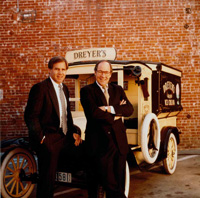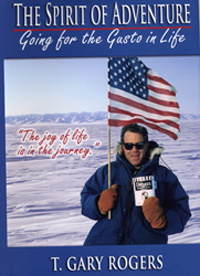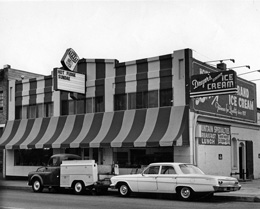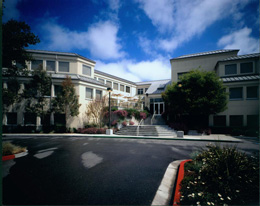
About the project
The Oral History Center (then the Regional Oral History Office) of the Bancroft Library conducted an oral history project to document the history of the Dreyer’s Grand Ice Cream Company, interviewing some of the key people who built its local, national, and international presence. For the project, OHC conducted approximately 100 hours of interviews with the owners, investors, employees, and relevant individuals who helped make Dreyer’s Grand Ice Cream an international brand between 1978 and 2006.
Historical context
Over the past century and a half, California’s coastal Mediterranean climate and irrigated inland valleys provided insightful entrepreneurs in the Golden State, and the Bay Area in particular, opportunities to become leaders in food and wine agribusinesses. As a result, the state served as the springboard for numerous food and wine businesses to establish profitable regional operations. By the 20th century, these businesses emerged as integral parts of multinational diversified corporations and key players in the global economy. Examples of these companies include: coffee giants Maxwell House, Hills Brothers, and Peet’s; bread giant Boudin; Golden Grain Macaroni’s Rice-a-Roni; chocolatiers Ghirardelli and Scharffenberger; and wine giants, including Gallo and Mondavi. Yet, the story is somewhat bifurcated in that food became more than a business as it emerged as a marker for regional identity predicated upon enjoying fine local foods and imbibing world-class wines. The Bay Area’s post World War II era also nurtured regional food educators and practitioners that elevated the status of the region’s foodways. Herb Caen, Cecilia Chiang, Doris Muscatine, Narsai David, and Alice Waters, among others, became modern food pioneers dedicated to establishing a regional food identity. In the end, the best of the regional foodways became a focal point for businesspersons to grow local food businesses into profitable national and global brands.
Missing from the story is the role of Bay Area ice creams, such as Dreyer’s Grand Ice Cream, that played a vital role in this process. Dreyer’s serves as an important case study for the route of developing a local business and growing it to the regional, state, national, and eventually global marketplace. Founded in 1928 and opened on Oakland’s Grand Avenue, Dreyer’s ice cream business survived the challenges of the Great Depression and World War II by producing quality ice cream and developing new brand awareness built upon their invention of Rocky Road ice cream. Over the next few decades Dreyer’s became the largest American ice cream company and, in 1981, the corporation began to trade shares on the NASDAQ. The company's entrance into the global marketplace came in 2006 when Nestlé Corporation acquired 67 percent of their shares and thus became the world's largest producer of ice cream.
Project team (active circa 2010-14)
Victor W. Geraci, project director and interviewer; Shanna Farrell, interviewer; Robin Li, interviewer; Linda Norton, editor; and David Dunham, technologist
Project resources
Video excerpt
The Mother of All Parties
A brief timeline of ice cream and Dreyer’s Grand
200 BC
Widely believed to be the first “ice cream” developed in China by freezing a soft mixture of milk and rice and packing it into snow.
2nd Century AD
Arab medical historian Ibn Abu Usaybi offers first technical description of ice-making using salt, a technology that likely came originally from China.
7th Century
First documented evidence of ice cream production shows Chinese cooks fermenting, flavoring, and freezing a mix of buffalo, cows’, and goats’ milk during Tang Dynasty.
1660s
Using salt to freeze foods done in Europe for first time: sorbets and ices made with sweetened milk in Naples.
1686
After opening a chain of coffee houses across Central Europe, impoverished Palermo aristocrat, Francesco Procopio Dei Coletti, opens the first café in Paris. “Café Procope” debuts frozen ices, custards and creams, marking the beginning of the gelateria.
1700s
French begin using egg yolks in their ice cream production, marking the origin of custard-based (or “French-style”) ice creams. First known written ice cream recipes appear in the unsigned manuscript L’Art de Faire des Glaces (1700).
1744
Colonist William Black mentions “fine Ice Cream” being served at a dinner party given by Maryland Governor Thomas Bladen, the first record of American ice cream.
1777
Phillip Lenzi advertises the sale of ice cream at his New York City confectioners shop, likely the first retail ice cream location in the US (established c.1774).
1781
Lenzi-competitor Joseph Corre first to advertise the sale of “Ice Cream” by that name.
1792
First ice cream recipe published in the US appears in Richard Briggs’ The New Art of Cooker, According to the Present Practice (W. Spotswood, R. Campbell, and B. Johnson: Philadelphia, PA), 1792.
1802
Thomas Jefferson becomes the first US President to serve ice cream at the White House. Jefferson also credited with bringing “French-style” ice cream (made with egg yolks) to the U.S.
1807
First documentary evidence of an “ice cream cone” appears in the colored engraving “Frascati” by Parisian artist Louis-Philibert Debucourt. The picture depicts a young woman licking an ice-cream cone in the Neaopolitan-owned Café Frascati. This image challenges the commonly-held belief that the ice cream cone was invented at the 1904 St. Louis World’s Fair.
1820s
Augustus Jackson, former White House cook, moves to Philadelphia and begins catering business supplying ice cream to customers and several African American-owned ice cream parlors. Becomes one of Philadelphia’s wealthiest African Americans, often erroneously referred to as “the man who invented ice cream.” Credited with creating many new ice cream recipes.
1843
Nancy Johnson develops and patents first hand-crank ice cream maker. Sells patent to William Young for $200, who names it the “Johnson Patent Ice-Cream Freezer”
1851
Quaker dairy-delivery entrepreneur Jacob Fussell establishes the first large-scale commercial ice cream plant in Seven Valleys, Pennsylvania. Later moved to Baltimore to be closer to the consumer market.
1870s
Development of industrial refrigeration by German engineer Carl von Linde eliminates the need to cut and store natural ice.
1876
The Centennial Exhibition of 1876, held in Philadelphia, brought national attention to the Philadelphia ice cream culture and popularized “Philadelphia-style” ice cream, made without eggs, or with only egg whites.
1890s
In the United States, the French phrase, “à la mode,” used to mean “served with ice cream.”
1899
August Gaulin of Paris invents the homogenizer, which is used to develop the smooth texture of ice cream. US annual ice-cream production (in gallons): 5 million
1905
Thomas D. Cutler founds The Ice Cream Trade Journal. In New York City, Emery Thompson develops the gravity-fed batch ice cream freezer, which allowed for continuous production.
1906
As the galley boy, William Dreyer given the prestigious job of producing ice cream to celebrate his German ship's arrival in America. After a brief stint making ice cream in New York City, relocates to Northern California to begin a twenty-year apprenticeship with Peerless Ice Cream and National Ice Cream Company.
1909
Chicago leads the way towards safe dairy and ice cream production with the first compulsory pasteurization regulation. U.S. annual ice-cream production (in gallons): 30 million.
1919
U.S. annual ice-cream production (in gallons): 150 million
1920
First ice cream filling and packaging machines introduced by Mojonnier Brothers and Sealright.
1921
Dreyer opens his own ice creamery in Visalia and wins first prize at Pacific Slope Dairy Show.
1920s
Dreyer begins teaching ice cream courses as the Professor Advanced Ice Cream Manufacturing at the University of California, Davis and serving as an officer in the California Dairy Industries Association.
1923
Nizer Cabinet Company introduces the first automatic electric freezer.
1926
National Ice Cream recruits William Dreyer to run a large new plant in Oakland. Clarence Vogt of Lexington, Kentucky develops the first commercially adopted continuous-process freezer.
1928
Dreyer partners with successful Bay Area candy-maker Joseph Edy to found a small ice cream factory on Grand Avenue in Oakland, California, named the Grand Ice Cream Company, with a focus on creative innovation.
1929
Purportedly calming his nerves after Black Thursday, Dreyer adds walnuts (later replaced with almonds) to his chocolate ice cream and, using his wife's sewing shears, cut marshmallows into bite-sized pieces to make the first batch of Rocky Road, a name that gave people something to smile about in the face of the Great Depression. (note: An 1853 Australian confection, sold under the same name, was made of chocolate, marshmallow, nuts, and other fillers and sold to gold miners who travelled the “rocky road” to get to the Australian gold fields.) Prior to this, ice cream had been primarily sold in vanilla, chocolate or strawberry flavors and this marked one of the first flavor combination ice creams. Edy and Dreyer are also credited with creating Toasted Almond and Candy Mint.
1934
Thomas Carvelas, a Greek American, begins selling ice cream in New York and invents a freezer that allows him to make soft “Carvel” ice cream. Pairs American love of ice cream with the romance of car culture, and establishes an ice cream empire of roadside ice cream shops.
1946
Dreyer’s only son, William Dreyer, Jr. enters the business. Edy shifts focus exclusively to candy business.
1947
Joseph Edy and William Dreyer, Sr. officially dissolve their partnership.
1948
Dreyer builds a state-of-the-art ice cream plant in Oakland, California and renames the company Dreyer’s Grand Ice Cream, Inc.
1953
Dreyer retires and passes management of the company on to his son, “Junior,” though remains active in the company until his death in 1975.
1963
“Junior” sells the company to his key officers – Al Wolff, Bob Boone and Ken Cook.
1977
Fraternity brothers and struggling restauranteurs William Cronk and Gary Rogers buy Dreyer’s for $1.1 million.
1979
Cronk and Rogers introduce Dreyer’s to markets in Washington, Oregon and Arizona while remaining committed to the company’s unique Direct Store Delivery (DSD) model. Model includes using own trucks, drivers, routes and running in-story inventory to insure quality control. As East Coast-based Breyers Ice Cream (owned by Kraft Foods) and West Coast-based Dreyer’s expand into national markets, concerns about brand confusion leads Dreyer’s to agree to use the brand name “Edy’s” in the Eastern U.S. market.
1981
Sales reach $30 million, from $6 million at time of Cronk/Rogers acquisition. Dreyer’s goes public with shares traded on NASDAQ under the ticker symbol DRYR. Dreyer’s President Ken Cook enters the vanilla business, and since then Dreyer’s ice cream has been made with Cook’s Vanilla produced by the Cook Flavoring Company. $45 million Initial Public Offering.
1982
Official ice cream taster John Harrison invents Cookies ‘n’ Cream flavor ice cream.
1983
Begins expansion across the Rockies with introduction of Edy’s brand to St Louis, Milwaukee and parts of Ohio. At this point, Dreyer’s had experienced a 959 percent increase in sales since acquisition by Cronk and Rogers
1980s
As company expands, T. Gary Rogers composes the “I Can Make a Difference” philosophy defined by ten tenets, or “Grooves” that aim to empower individuals to realize their potential and promote a cohesive corporate culture.
1985
To accommodate growing East coast distribution needs, Dreyer’s acquires Maryland-based Berliner Foods Corporation.
1986
Acquires Midwest Distributing Company to enter Minnesota, Wisconsin and Michigan markets.
1987
Dreyer’s becomes first premium ice cream maker to introduce products for the health-conscious consumer, invents proprietary process that produces the first “light” ice cream. The company becomes distributor for Ben & Jerry’s, helping to cover the high cost of company-owned DSD trucks. Dreyer’s Grand Ice Cream Charitable Foundation established, supporting community, youth and K-12 public education programs, focused on communities that are home to Dreyer’s operating facilities. Embarks on five-year marketing plan to double sales by the end of the decade.
1989
In addition to an expanded distribution relationship, Dreyer’s begins manufacturing ten percent of Ben & Jerry’s “super premium” pint-sized ice cream at its plant in Fort Wayne, Indiana.
1990
Dreyer’s introduces new cholesterol-free frozen dessert called American Dream. Less than 1 % fat and 80 calories per three once serving.
1990s
Partners with Nissho Iwai Corporation to market and sell Dreyer’s products in Japan. Pressure from the U.S. forces Japan to lift restrictions on dairy imports, allowing Dreyer’s to ship directly to Japan from manufacturing sites in California. Rising dairy prices stifle market expansion.
1992
Unveils Dreyer’s and Edy’s No Sugar Added ice cream lines, to great success. Expands overseas sales to include exporting to countries in Asia, Pacific Islands, Caribbean and South America.
1993
Anglo-Dutch company Unilever outbids Dreyer’s for acquisition of Breyers. Unilever also purchases Gold Bond-Good Humor Ice Cream Company and renames the brand to Good Humor-Breyers Ice Cream Company, continuing the trend towards the globalization of the ice cream industry.
1994
Nestlé acquires approximately 30% of the company.
1995
Dreyer’s succeeds in 14-year struggle to exceed Breyer’s sale, becomes the leading packaged ice cream brand in the U.S. market. In celebration, the company held the Mother of All Parties (MOAP), chartering three DC-10s to bring all employees to Oakland for an “I Can” theme party. Also expands its charitable work with the launch of the Grand Expectations Program.
1996
Oakland City Council votes 8 to 0 to allow 57,000 square-foot $15 million expansion of Oakland manufacturing facility.
1996
30% jump in dairy prices due to drought conditions in dairy states and weakening demand for ice cream hurts profitability.
1998
200,000 people a year take the Dreyer’s factory tour. Michele Massari tour-guide
1998
For the first time Dreyer’s cuts 100 jobs, mainly through attrition, and sells some operations to trim costs and return to profitability. Ben & Jerry’s Homemade Inc. of Vermont rebuffed a purchase offer from Dreyer’s Grand Ice Cream, strains distribution relationship. New CFO Tim Kahn committed to “greening” the company, makes truck routes and freezer cycling more efficient.
1999
Virginia-based Mars confectioners partners with Dreyer's to create popular “mix-ins” ice cream products (Snickers Ice Cream bar). Ended with Nestlé buy-out in 2002.
1999
September Dreyer’s launches super-premium Dreamery line…to counter the category 42% Haagen-Daz and 38% Ben & Jerry shares of the super-premium market. These pint ice creams offer high margins of profitability. Dreamery line quickly gets 14% of market share.
1999
Nestlé USA joint venture with Häagen-Dazs Plc for super-premium line just at time Dreyer’s launching super-premium Dreamery line. But deal is really a move to someday-own Dreyer’s for its distribution system. Dreyer’s already distributes Nestlé novelties and Ben & Jerry’s.
2000
Company installs voice-enabled picking systems in warehouses to maintain worker comfort and productivity in 20 degrees below zero work environment. Distribution center productivity increases fifteen to twenty-five percent, mispick rates plummet.
2002
Nestlé acquires 67% of the company, with rights to purchase the rest by 2006. T. Gary Rogers retains post of Chairman and Chief Executive, President William F. Cronk
2003
W.F. (Rick) Cronk, President of Dreyer's, retires after 26 years in the ice cream business.
2004
Produced using a new churning process called “low-temperature extrusion”, Dreyer's and Edy’s Slow Churned™ Grand Light® Ice Cream has half the fat and a third fewer calories than full-fat premium and takes the ice cream world by storm.
2004
Dreyer’s expands with an East Coast plant in Laurel, Maryland.
2004
Dreyer's acquires Silhouette Brands and its low-fat and low-carb frozen snacks brands, Skinny Cow® and Skinny Carb Bar™.
2004
Dreyer’s buys franchise rights to all 236 Häagen-Dazs shops in the US from General Mills of Golden Valley, Minnesota.
2005
Dreyer’s debuts “Slow Churned” ice cream recognized as Best New Product of the year by four industry publications.
2006
Nestlé takes full ownership of Dreyer’s Grand Ice Cream, and becomes world’s biggest ice cream manufacturer with 17.5% of the market share.
Bibliography
Berger, Jonah, Michaela Draganska, and Itamar Simonson. 2007. “The influence of Product Variety on Brand Perception and Choice.” Marketing Science 26 (4) (Jul - Aug): 460-72.
Breedlove, L. B. 1932. “The Ice Cream Industry: Its Economics and Future.” The Journal of Land & Public Utility Economics 8 (3) (Aug): 234-47.
“Claim Check - Dreyer's/Edy's Grand Light Ice Cream.” 2004. Consumer Reports: 6.
Cohen, Ben and Jerry Greenfield. Ben & Jerry’s Double Dip: How to Run A Values-Led Business and Make Money, Too. New York; Simon and Schuster, 1997.
Dreyer’s Grand Ice Cream, Inc. “Grooves:” The Dreyer’s Philosophy, 2003 (pamphlet).
Dreyer's Ice Cream, Bakersfield. 2006. Dairy Record. 107 (8): 102-13.
EIP Associates and Oakland (Calif.) City Planning Dept. 1989. Dreyer's Grand Ice Cream Office Project: Draft Environmental Impact Report. San Francisco: The Associates.
Hawkes, Jerry M., James D. Libbin, and Jeremy D. Kohler. 2004. Can Ranch Owners Include the Ranch in an Investment Portfolio? Rangelands 26 (6) (Dec): 31-9.
"Ice Cream Scoops - Dreyer's/Nestlé Has Growing Pains.” 2004. Quick Frozen Foods International. 45 (3): 29.
“Ice Cream Scoops - Nestlé Closes (USD) 2.8 Billion Dreyer's Deal After Clearing US Regulatory Hurdle.” 2003. Quick Frozen Foods International. 45 (1): 10.
Kaven, William H., and David L. Call. 1967. Private-Label Marketing in the Ice-Cream Industry. The Journal of Marketing 31 (1) (Jan): 35-8.
Keller, Kevin Lane, and Donald R. Lehmann. 2006. Brands and Branding: Research Findings and Future Priorities. Marketing Science 25 (6) (Nov - Dec): 740-59.
Lane, Vicki, and Robert Jacobson. 1995. Stock Market Reactions to Brand Extension Announcements: The Effects of Brand Attitude and Familiarity. The Journal of Marketing 59 (1) (Jan): 63-77.
“New Dreyer's Grand Ice Cream Flavors.” 2002. Dairy Record. 103: 20-1.
“New Products & Marketing - New Product Review - New Dreyer's Grand Ice Cream Flavors, Indian Ethnic Cheese, Fruit Dips for One, and Organic Pudding.” 2002. Dairy Foods. 103 (5): 20.
Nowlis, Stephen M., and Itamar Simonson. 2000. “Sales Promotions and the Choice Context as Competing Influences on Consumer Decision Making.” Journal of Consumer Psychology 9 (1): 116.
Pava, Moses L., and Joshua Krausz. 1996. The Association Between Corporate Social-Responsibility and Financial Performance: The Paradox of Social Cost. Journal of Business Ethics 15 (3) (Mar): 321-57.
“Plant of the Year Dreyer's Grand Ice Cream.” 2006. Food Engineering 78 (4): 57-71.
“Plant Operations and Packaging - Plant Feature: Dreyer's Ice Cream,” Bakersfield. 2006. Dairy Foods. 107 (8): 102.
Quinzio, Jeri. Of Sugar and Snow: A History of Ice Cream Making. Berkeley: University of California Press, 2009.

Rogers, T. Gary. The Spirit of Adventure: Going for the Gusto In Life. Oakland: T. Gary Rogers, 2007.
Rogers, T. Gary and Jerome S. Engel, Berkeley Entrepreneurs Forum, Lester Center for Entrepreneurship & Innovation., and Audio Visual Consultants. 1994. Entrepreneurship and Ice Cream. Oakland, CA: Audio Visual Consultants.
“Rollout! Frozen Delights: New Häagen-Dazs Low-Fat Ice Cream, Plus the Latest Starbucks/Dreyer's Flavors.” 1997. Food Processing. 58 (2): 36.
Schmidt, Lisa. 1985. Rocky Road : Dreyer's Ice Cream vs. Rockridge. Express. 8 (8).
Simon, Carol J., and Mary W. Sullivan. 1993. The Measurement and Determinants of Brand Equity: A Financial Approach. Marketing Science 12 (1) (Winter): 28-52.
Simonson, Itamar, Stephen M. Nowlis, and Yael Simonson. 1993. The Effect of Irrelevant Preference Arguments on Consumer Choice. Journal of Consumer Psychology 2 (3): 287-306.
“Special Features - Light and Easy - Ice Cream Outlook 2006.” 2006. Dairy Foods. 107 (3): 32.
Targan, Barry. 1983. The Emperor of Ice Cream. The Sewanee Review 91 (1) (Winter): 17-52.

